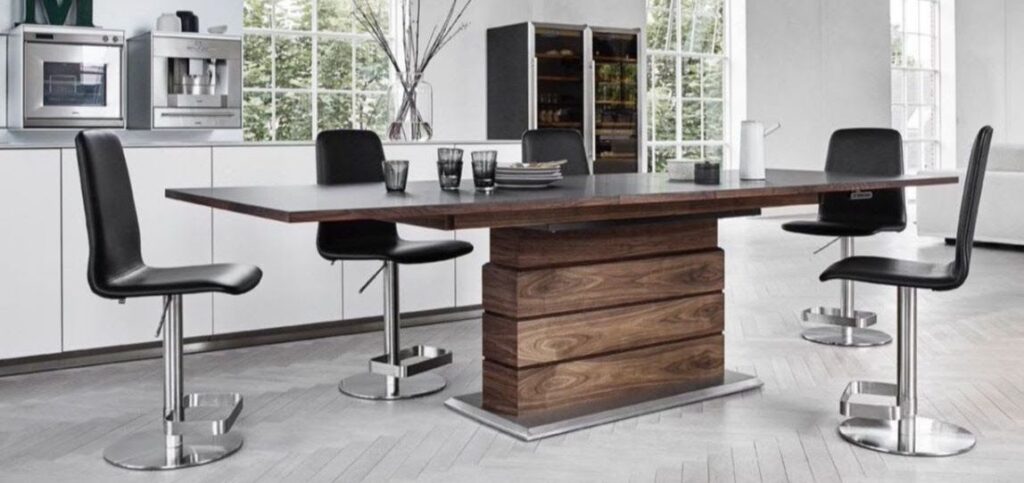

Egg chairs, Mid-Century Modern platform sofas, minimalist dining tables and armoires – Danish furniture meshes well with a lot of today’s contemporary interior design. Favoring simplicity, it does away with any unnecessary bulk and prioritizes functionality.
Architect Frank Lloyd Wright embraced the Danish style for Fallingwater, the architectural marvel he designed in the 1930s for an area in rural Pennsylvania. The modern home was built above a natural waterfall for the Kaufmann family, owners of a prominent department store chain at the time. Inside, he turned to functional furniture with a streamlined look from Denmark to complement and not distract from architectural details and art pieces the family collected from around the world.
The distinctive, humble Danish approach to furniture design hasn’t changed much since it was popularized in the 1950s. Even after decades of furniture and interior trends in America, these four elements of Danish furniture design are still as alive and relevant today as ever.
Danish furniture is crafted with a person’s size and their living environment in mind. Living spaces in Europe and Scandinavian countries are usually small. With long, cold winters, larger homes are harder to heat, so the responsibility of furniture is to be useful in a space while not cluttering or overtaking it. So, you won’t find bulky legs on sofas and tables. The aesthetics are in the cleanliness of the design and the natural beauty of the materials.
“The designs have a specific purpose. Some forms may be unnecessary, so when you start adding decoration, then you start losing some of the reason for it being there. Form and function kind of fall apart,” said Jens Hansen, co-owner of Copenhagen Imports, in Arizona and Texas.
In America, Danish furniture pieces are very popular for people living in smaller homes, apartments, condos, and for downsizing families learning to do more with less, explains Hansen.
Danish design uses resilient, durable and high-quality wood that can last decades. Walnut, elm or oak woods are popular, and teak, a durable wood used in shipbuilding that handles moisture well, has been a mainstay in Danish furniture construction for decades.
With their simple, utility-first approach to design, the Danish use wood only in the doses required for a piece. Dining room tables or office desks often have thin, straight or slanted legs. Dining room chair legs can also look thin, but owners are often surprised by how long these pieces last, thanks to design, workmanship and the right materials. And comfort, even in a wood-only piece of furniture, is still a primary consideration.
“You don’t have to use a giant tree log to produce a chair as long as it’s properly designed,” Hansen added. “And with the right design and its back aligned the right way, even all-wood chairs without fabric can be very comfortable.”
Maurice Brantley, Copenhagen’s head of interior design, says the comfort, even with minimalistic pieces, reflects “a strong craft tradition that is really focused on utility, but also coupled with a human-centered approach to design, also an abiding respect for the past.”
Even with an emphasis on utility and simplicity, Danish design isn’t all work and no play. In fact, coverings come in a wide range of colors that are flexible for many different environments.
As is expected, Danish coverings blend well with the environment. So, you’ll find your share of neutrals such as soft tans, cognac-colored leather, along with vibrant but relaxed orange or a soft Laguna blue on couches, recliners, chairs and sofas. They’re all colors that catch your attention without overwhelming.
At the same time, designers like Josef Frank, an Austrian-born architect who later opted for Swedish citizenship in the 1930s, introduced iconic fabric patterns and prints you’ll find today on accent pillows with pops of color that break from the neutrals. These designs may include radiant flowers and leaves in blues, greens and yellows that find their place on a wide range of couches or sofas.
“You do find them (Danish designers) incorporating these bright-colored textiles, vivid prints that give a sense of joy when you look at them,” Brantley added
If there is an award for stubborn adherence to founding principles, Danish furniture designers win it every time.
Danish design has taken ergonomics into consideration, and in cases like desks or recliners, you’ll now find additions like technology ports and plug-ins. The furniture has also scaled to the slightly larger human being. Even still, Danish design does not stray from its utility and roots in simplicity.
“Every design element in the product has a reason for being there. They don’t require any kind of enhancement or purely decorative element to create a beautiful product,” Hansen said.
And that likely won’t change anytime soon.